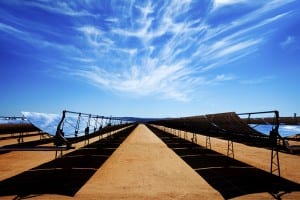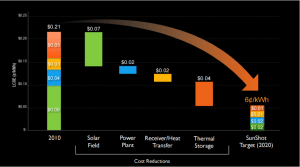CSP vs PV – Understanding the current situation and future outlook
By Seyed Mohammad Mehdi Mohaghegh Ahmadabadi, on 30 November 2015
Throughout COP21 our staff and students will be blogging on climate change and sustainability.
Next month, the largest concentrated solar power plant (CSP) in the world will launch its first phase at the Moroccan city of Ouarzazate on the edge of the Sahara desert. The project consists of four plants and could generate 580 MW of electricity. This possibly will be enough to supply electricity to more than a million homes in Morocco. The first phase of the project, called Noor1, has the generating capacity of 160MW.
In regards to its scale, this project is a significant step for the solar industry and Morocco’s energy transition plan. Morocco is among the few lower-middle income countries, which adopted a robust renewable energy target and relevant policies. In this regard, they have set an ambitious target of supplying 42% of electricity from renewable sources by 2020. To meet this target they have implemented regulatory policies such as tendering and different types of fiscal incentives such as public investment, loan and grants. When all the phases of this new CSP project go live, it could cover around 10% of Morocco’s electricity demand.
Solar power plant in some way is a misleading term. Many among the public normally perceive them as being photovoltaic systems (PVs) when hearing the term. However, the project in Morocco is concentrated solar power (CSP). This type of technology, also named as solar thermal power plant, could generate electricity through using sunlight to heat fluid. Similar to other conventional fossil fuel power plants, the heated fluid could be used to produce steam that drives a turbine-generator set with efficiencies that are bound by thermodynamic laws. On the other hand, PV systems use solar cells and directly convert sunlight into the electricity without any moving parts.
Currently PV systems are the most widely deployed solar electric technology in the World. By the end of 2014, there were more than 140 GWs of installed capacity of photovoltaic systems across the globe while less than 5 GWs of CSP technology is currently being used in the energy sector. Here we will try to shed some light on why there is a considerable gap between PV and CSP development and how the future trend will be shaped.
One size doesn’t fit all
PV systems can be installed almost everywhere CSP can, but not the other way around. PV could cover both the residential and power plant sector. However, current commercial CSP technologies are only feasible at large-scale projects typically those with more than 20MW. There are many PV systems with few kWs of solar panels installed in the residential areas across the world. In other words, PV plants could provide opportunity for development of distributed and decentralized power while CSP plants do not scale down well and the transmission grid is essential for CSP development. It is not the only technical factor that make the CSP’s market smaller than that of the PV. The CSP system only works with direct irradiation while PV systems could even use the diffuse radiation. Therefore, the PV could be installed in any location while the suitable areas for CSP are much more limited. This issue has led to a much larger market for PV and as a result, more tech companies, research centres, investors and policy makers have gotten interested in PV rather than CSP.
In addition to the market size, technological simplicity has helped PV to deploy much faster than CSP. The PV system mainly revolves around solar cells while CSP power plants are a combination of many critical mechanical and chemical components. Therefore, this fact has helped companies and research centres in the PV industry to be able to focus on limited numbers of issues such as increasing the solar cell efficiency and driving down the cost. This issue has accelerated the price reduction of silicon based PVs in past decade.
One of the points, which could be seen as an advantage for the CSP system, is possibly of heat storage. In power plant projects, supplying power during the peak time is a critical and challenging point. Currently in PV systems, electrical storage is not feasible, so they usually can only cover the daytime demand. However, the CSP System provides the ability to incorporate simple, efficient, and cost-effective thermal energy storage by virtue of converting sunlight to heat as an intermediate step to generating electricity during the peak time. Thermal energy storage for use in CSP systems is achievable by different technologies. It could be one of sensible heat storage, latent heat storage using phase change materials (PCMs) or thermochemical storage. The possibility of heat storage in CSP plants categorises this system among “Dispatchable generation” technologies.
Environmental costs
CSP and PV power plants also could be compared from the perspective of environmental impacts and natural resource requirements. Both CSP and PV systems require a significant amount of land in comparison with conventional fossil fuel plants for their operation. In average CSP plants occupy 10 acres/MW and PV plants require 8 acres/MW. The CSP plant in Morocco, when all its four phases finish, will occupy an area as big as Morocco’s capital city (Rabat). From a material point of view, CSP plants require a considerable amount of iron and cement while PV plants require some critical materials such indium and rare earth elements in their manufacturing process.
CSP breakthroughs
There are some potential technological breakthroughs, which could accelerate the CSP development. Currently many research teams are investigating the solar-thermal synthesis of combustible or electro-chemically consumable fuels that have sufficient energy density to be transportable for conversion to electricity, or in transport applications. These researches are generally categorised under the “solar fuels” field. This could help to expand the CSP application into the energy sector and provide more market for this technology.
In addition to this new field (solar fuel), there are some national funded research programmes for supporting CSP technology. In the USA, the SunShot programme, which is a national programme aimed to make CSP cost competitive with other renewable technologies without subsidies by 2020. The below figure shows the cost reductions in different part of CSP technology that are being targeted by 2020.
By comparing the trend of the CSP development with other renewable sources, we can see that CSP is now at a turning point. The mass-manufacture of PV system and government subsidy schemes have resulted in the development of low cost high-efficiency multifunction cells. For CSP systems, the cost of mirrors, vacuum receiver, lenses, support structure, high-efficiency heat transfer fluid and turbine have affected the initial and operational costs of the CSP project significantly and a result uncompetitive in most scenarios. In the most optimistic scenarios, CSP systems could supply around 10 % of global electricity. However most of the scenarios are pointing out that deployment of CSP plants would remain slow in the next 10-15 years compared with previous expectations.
Seyed Mohaghegh Ahmadabadi is a Doctoral Researcher at the UCL Institute for Sustainable Resources
4 Responses to “CSP vs PV – Understanding the current situation and future outlook”
- 1
- 2
- 3
- 4
 Close
Close




[…] photovoltaic (PV) and concentrated solar power (CSP). You can read more about the differences here. However, the important takeaway is that for a residential system, you’re usually going to be […]